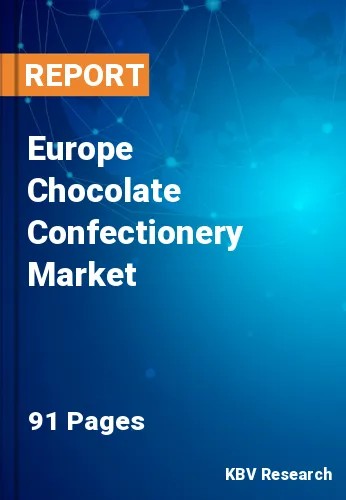The Europe Chocolate Confectionery Market would witness market growth of 6.2% CAGR during the forecast period (2022-2028).
In recent years, the idea of a healthy diet has evolved dramatically. Traditionally, meals like sweets and snacks were thought to provide nothing but empty calories, contributing to obesity and raising the risk of a variety of illnesses. However, nowadays, people's eating habits have been shifted toward more nutrition-based products. Chocolates have various benefits if consumed in an appropriate quantity. For example, eating dark chocolates aids in fat loss while eating milk chocolates significantly helps in boosting blood pressure. Due to these benefits, the demand for chocolates is expediting across the region.
Furthermore, as health and wellbeing have become a key priority, an increasing number of customers throughout the world are pursuing healthy eating lifestyles with specialized demands and seeking the best options for them. Moreover, a significant number of people all over the world prefer dark chocolate confectionery goods because they believe it provides health benefits. Such factors are likely to help the entire market for healthier products increase.
Europe is also a major market for chocolate confectionery items due to the increasing production of chocolates across the region. Germany, Switzerland, Belgium, Austria, and the United Kingdom are the major producers as well as consumers of chocolate in Europe. These countries have a higher per capita chocolate consumption than countries in other areas. Cacao beans or processed chocolates are used as the primary raw material in the manufacturing of chocolate confectionery. Specifically, Europe provides a diverse selection of chocolate products, such as Fry's chocolate cream, white chocolate, milk chocolate, dark chocolate, and others. It is expanding the range of the chocolate confectionery market in the region.
The chocolate confectionery market in Europe is centered in Germany. Germany is one of the largest importers of cacao beans in Europe. A white organic yogurt chocolate bar flavored with pepper and lemon zest was also given by Gepa – The Fair-Trade Company in Germany. In addition, Kaoka, a German manufacturer, has created organic dark chocolate with buttery crispy crepes. All of these advancements, as well as Germany's import values, will have a direct impact on the demand for chocolate confectionery in the coming years. This factor is accelerating the growth of the regional chocolate confectionery market.
The Germany market dominated the Europe Chocolate Confectionery Market by Country 2021, and would continue to be a dominant market till 2028; thereby, achieving a market value of $21,745.1 million by 2028. The UK market is anticipated to grow at a CAGR of 5.3% during (2022 - 2028). Additionally, The France market would witness a CAGR of 7% during (2022 - 2028).
Based on Type, the market is segmented into Milk, Dark, and White. Based on Distribution Channel, the market is segmented into Supermarkets & Hypermarkets, Convenience Stores, Online, and Others. Based on Product, the market is segmented into Molded Bars, Chips & Bites, Boxed, Truffles & Cups, and Others. Based on countries, the market is segmented into Germany, UK, France, Russia, Spain, Italy, and Rest of Europe.
Free Valuable Insights: The Global Chocolate Confectionery Market will Hit $265.9 Billion by 2028, at a CAGR of 6.7%
The market research report covers the analysis of key stake holders of the market. Key companies profiled in the report include Ferrero Group, The Hershey Company (Hershey Trust Company), Lindt & Sprungli AG, Mars, Inc., Mondelez International, Inc., Nestle S.A., The Barry Callebaut Group, Lotte Corporation, Lake Champlain Chocolates, and CÉMOI Group.
By Type
By Distribution Channel
By Product
By Country
Our team of dedicated experts can provide you with attractive expansion opportunities for your business.

